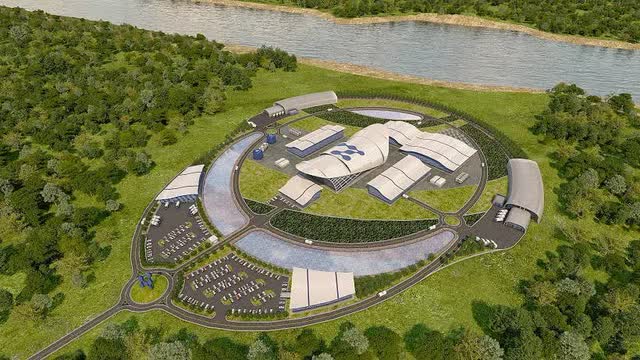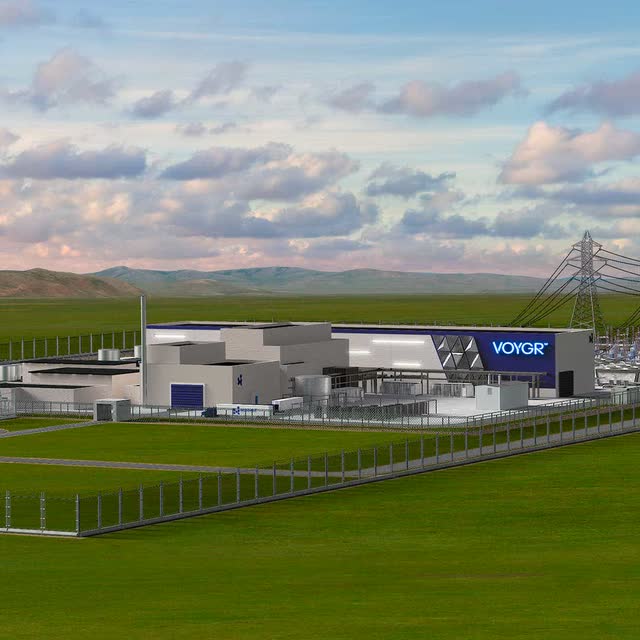SMR Nuclear Dreams: NuScale’s Reality Fades (NYSE:SMR)


Orhan Turan
The World Nuclear Association’s “Nuclear Power in the European Union” reads like a history of an industry in decline, notwithstanding that it has an “Updated December 2023” byline. There’s little evidence of any new developments and the big news is mostly about small extensions to nuclear closures. The current buzzword, SMR (Small Modular Reactor) gets a mention, but a very muted one. Nuclear plant construction is currently underway in only two EU member states (France and Slovakia) which have experienced delays and cost overruns. Nuclear capacity is expected to decline in the near term. The darling of the US nuclear industry has been NuScale (NYSE:SMR), with very public claims to be close to signing off on a major project, although it has just been cancelled. Here I provide a glimpse into the emerging(?) SMR industry and consider where NuScale fits into the picture. The picture isn’t pretty.
Some background on SMR (Small Modular Reactors)
Contrast the World Nuclear Association summary above with many effusive reports representing that the SMR has an already established presence. The point is that when one comes to SMR projects implemented, the cupboard is almost bare. It’s a tough time to be an investor in a company planning to sell SMRs.
About the most concrete information concerning SMR implementation that I found (apart from individual company promotion of the potential of their SMR technology) was an October 2023 press release from UK Government company Great British Nuclear (Officially British Nuclear Fuels Ltd). This release refers to six companies that have been shortlisted for a UK nuclear competition. The goal is to firm up actual SMR candidates for a potential UK SMR program, with a goal to provide 25% of UK power from nuclear by 2050. If you read the press release you could assume that the SMRs described actually exist as operating facilities. The way they are described is as follows: “Unlike conventional nuclear reactors that are built on site, SMRs are smaller, can be made in factories, and could transform how power stations are built by making construction faster and less expensive.” Of course tricky things like approvals, security, safety, etc., get no mention. With a large nuclear reactor the huge cost of regulatory approvals gets covered by substantial power production. It’s hard to imagine that a series of small reactors could be cheaper to get approved in terms of unit power output.
The October 2023 press release foreshadows a series of SMRs operating by the mid-2030s. The plan is to announce in spring 2024 which of the six companies the UK government will support, with a plan to award manufacturing contracts by summer 2024. This seems just more wishful thinking, and indeed within the above press release Gwen Parry-Jones (CEO of Great British Nuclear) mentions final investment decisions in 2029.
The shortlisted companies are:
1. EDF (Owned by French Government): NUWARDTM, a Gen III+ pressurised water reactor (340MWe). EDF claims in-factory manufacture. Designed for load following capacity (which must make the cost of power more expensive). This project is moving from conceptual design to basic design phase. The goal is for approval for manufacture in 2030, with a three-year construction phase. This is clearly more complicated than assembling the plant from the back of a truck.
2. GE Hitachi (GE)(OTCPK:HTHIY): BWRX-300, an Economic Simplified Boiling Water Reactor (ESBWR) (300 MWe). This instrument is based on the design of an already operating (larger) Gen III+ system. This system seems to have a lot of passive safety systems. The claim is that manufacturing of this plant would be based on proven technologies in the oil and gas industry. Construction time is still estimated as two to three years. The claim is that this is the 10th evolution of a BWR light water reactor design from GE. While there’s no concrete information, the claim is that the first BWRX-300 system could be operational by 2028-2029.
3. Holtec (Private): SMR-160+ PWR (Pressurised Water Reactor) has been in development since 2010! It has an underground core and steam supply system. The system has passive cooling which can operate indefinitely after shutdown. Holtec talks a good talk with plans for 32 SMR-160s by 2050 across the UK. Getting one established and validated as an economic system would be a good start. Amongst a number of deals, Holtec has a signed collaboration deal with Hyundai Engineering & Construction for global rollout of the SMR-160. Hyundai plans to develop an integrated 3D plant model for construction. Lots of hype.
4. NuScale (SMR): NuScale Power Module is a multimodule (six or 12) unit with 77MWe basic structure PWR. NuScale talks about lots of deals, including in Poland and Romania, but its first deal with UAMPS (Utah Associated Municipal Power Systems) has fallen through because of cost escalations. NuScale has just announced full time staff cuts of 28% and $50-$60 million annual savings. This looks serious for a company moving to commercialize its technology.
5. Rolls Royce SMR (OTCPK:RYCEF): A 470 MWe PWR which like other SMR announcements focuses on factory manufacture and modularization, reducing on site construction. Rolls Royce claims to be two years ahead of its competitors in progressing toward European regulatory approvals. Planned construction is still early 2030s. The company talks up number of its SMRs it expects to build, but at this stage there is no clear customer.
6. Westinghouse (NYSE:BBU): The AP300TM is a design derived from the operating AP1000 PWR. On this basis Westinghouse claims to have the only SMR based on a licensed and operating nuclear reactor design. The AP1000 has a checkered history of cost escalations in the US.
There’s clearly substance (and in some cases very deep pockets) to the six finalists in the competition. The thing that seems to be missing is absence of investors who think that any of these SMR projects might be financially viable. The thing is that renewable energy keeps getting cheaper while the nuclear industry continues to become a more expensive option.
Meanwhile the UK is still thinking about a new big nuclear reactor at Stillwell C. The Hinkley Point C reactors are delayed and get more expensive, now substantially more than offshore wind, with cost of power agreed to continue increasing for the next 35 years. The UK taxpayer looks like the loser in the Hinkley Point C program. Will the government commit to making things worse re cost of power by funding another large reactor?
What is driving the SMR programs?
Three things seem to be important:
i) An industry with lots of experience looking to find commercial success with a simplified reactor design;
ii) The fossil fuel industry looking for delay;
iii) Governments understanding the need to decarbonize yet unconvinced about renewables.
Why isn’t nuclear progressing more rapidly?
In a nutshell the nuclear industry has a terrible track record for on time and within cost nuclear construction. The scale of the capital costs is very large. Regulations are a major challenge. Just as is the case for fossil fuel power plants, nuclear power needs lots of water to operate a plant. Renewables don’t have significant need for water. The nuclear industry has still not addressed what to do with spent fuel, nor has the cost of closure of nuclear plants been fully contemplated.
The scale of cost reductions in renewables projects is astonishing, as is the short time needed to reach power production.
SMR technology aims to address some (not all) of the obstacles to nuclear power success.
Where does NuScale fit?
NuScale has a pole position in the US due to the company having the first and only SMR design (VOYGR) certified by the US Nuclear Regulatory Commission. The company isn’t modest about how it sees itself, with their website having the following byline: “Our small modular reactors outpace the competition on every level.” The company makes clear that, while it talks about its VOYGR technology as if it exists, reality is as follows: “NuScale’s VOYGR SMR design is ready to be built. We are positioned to take orders, not just make claims.”
How NuScale positions its product
So much of the SMR story is about images that project the future. Since at least 2019 NuScale used the following image to position its CFPP project. The same image was used in a story about the collapse of the CFPP project deal.

NuScale
Artist impression of the proposed Idaho CFPP VOYGR SMR project supplied by NuScale
The NuScale website now has a more prosaic image (below) of the new plans for the VOYGR SMR program. Reference to a water supply has gone, as is the space age view in the earlier image, which lacks boring things like connection to a power supply. The latest is a no nonsense image that seeks to make the SMR look like any other conventional power plant.

NuScale
NuScale’s Q3 2023
I’m a fan of quarterly reporting because ones get a sense of how the management is seeking to position their company. The Q3 2023 earnings call transcript of Nov. 8, 2023, is now a bit dated but it does provide insight as to how management is positioning pretty confronting news for the company. When your crunch-time product gets cancelled on the cusp of a triumphant go-ahead for completion, it’s about as big as it gets for management to cope with.
A press release on Nov. 8 announced that the UAMPS (Utah Associated Municipal Power Systems) and NuScale CFPP (Carbon Free Power Project) has been cancelled because there was insufficient support from the 50 members of UAMPS. These members come from Utah, Arizona, California, Idaho, Nevada, New Mexico and Wyoming. The point is that the cost for the NuScale VOYGR SMR had increased substantially over the past year and this seems to have been the sticking point for the CFPP members.
The start from CEO John Hopkins is one way of approaching the bad news: Just act as if it hasn’t happened…. “good afternoon everyone. Our industry leading position in the SMR space continues to grow. Our pipeline is stronger than ever, and we are nearing a realization of commitment to deliver reliable clean energy at scale.”
The thing is that this earnings call came on the back of cancellation of the project that the whole industry has been relying on to kick start the SMR revolution. The approach on the Q3 2023 earnings call was to talk up the next attempt to get a go-ahead to build the NuScale VOYGR SMR, and to rationalize that the cancelled CFPP program had achieved lots of success (before it was cancelled).
Finding a new customer
NuScale reinforced that it’s ready to build the first VOYGR system and that it has all the elements ready when/if there’s a go-ahead. With the failure of the CFPP program which was dependent on customers committing to fund the program, NuScale has formed a partnership with ENTRA1 Energy, which is described as an independent energy transition platform. The plan is for ENTRA1 Energy to develop, manage, own and operate a portfolio of energy plants powered by NuScale SMR technology. My take is that one client is the key and it still isn’t clear that there’s such a customer at this stage. NuScale is clear that it wants to stay with its special skills in technology development and design. The suggestion is that ENTRA1 Energy’s skills in pulling together a total package is the missing link for the success of its VOYGR SMR project. It was clear from Q&A on the call that there is considerable scepticism about the credentials of the ENTRA1 Energy team.
A customer, Standard Power, with a need to provide infrastructure-as-a-service to advanced data processing companies, has been identified and the plan is to partner with ENTRA1 Energy to provide almost 2 GW of clean carbon free energy. My problem is that 2 GW is equivalent to a big Gen III plant. It will be interesting to see whether providing 2 GW of power through a big Gen III facility, or a solar PV/wind farm will be more expensive than building two huge SMR plants each of which has 12 reactors in it. This seems a complex and costly way to build a big reactor. Time will tell if ENTRA1 Energy can develop a cost effective and timely plan and convince Standard Power. It seems as if two sites are planned (in Ohio and Pennsylvania), so each will be ~1 GW facilities. The projects are described as “base-load dispatchable energy options,” presumably in seeking to rule out solar PV or wind options. It will be interesting to see if the clients will be happy to rule out solar and wind because it isn’t dispatchable. Clearly with appropriate storage (grid-scale battery, pumped hydro or even power at a distance via HVDC cabling) renewables are possibilities and the cost comparisons would be interesting.
What’s the competitive edge that SMRs bring to nuclear technology adoption?
From the research that I’ve done, I’ve always thought that the SMR pitch is about small and agile nuclear power plant implementation. The largely unstated position is that this will result in a lower project cost (per unit of power) than a large Gen III reactor brings, although there seem to be questions about whether SMRs will be cheaper when the numbers are crunched. A big unknown with nuclear power execution involves unexpected cost escalations in construction and it does not seem certain that offsite modular construction removes risks of on-site construction escalation.
The IAEA (International Atomic Energy Agency) gives a broad brush summary of how attractive SMR technology is for places where big nuclear reactors are not possible and they state that there’s a cost advantage too. Of course the IEAE presentation is theoretical as there are no operating SMRs at this stage. Hence I’ve assumed that initial SMR projects would involve single small units to prove up the concept. These would be relatively cheap compared with big projects and hence should be attractive to groups interested in nuclear technology.
The way that SMR projects are presented invariably involves off-site manufacture of small nuclear reactors and hence a cost advantage over huge Gen III type of projects. The cost competitive edge has been largely unspoken as actual bottom up figures seem to indicate little if any cost advantage for SMR technology compared with big reactors.
The curious thing about the Q3 2023 earnings call was that the kind of projects that NuScale seems to be trying to get over the line are not “small” projects involving just 1 or 2 77 MWe reactors. Instead the project that NuScale represents that it is just about ready to build involves 24 SMR reactors spread over two sites! And all with a technology that is yet to be built.
CEO Hopkins makes clear that these are big and complex projects and NuScale has spoken with hundreds of potential customers. The challenge for investors is that NuScale is representing that the Standard Power deal is a done deal and time to move on to the next deal, at a time when little is clear about how this deal will be constructed, and if it stacks up against other options. NuScale got a long way with the CFPP deal before it fell over.
The deals that NuScale is exploring involve big data centers which consume a lot of power or replacing old coal plants. These don’t seem to necessarily fit with Small Modular Reactors. Renewables companies have established credibility in both data center projects as well as picking up the grid connections for solar and wind projects from old coal plants. This seems to be especially the case for offshore wind where connection with retired coal plants in both the US and Australia is being explored. It isn’t clear that SMRs have an edge in these big power options, especially because any nuclear project involves delays on a scale that renewables projects don’t have.
Getting down to details with the VOYGR
There’s no doubt that there are many customers seeking safe, reliable 24/7 carbon free energy. The question is whether NuScale’s VOYGR technology can deliver in a cost effective and timely way.
The talk in the Q3 2023 earnings report is of a $28 million contract as the start of the ENTRA1 Energy/Standard Power project. This sounds more like a feasibility study than a firm commitment to deliver the project. It’s concerning that this preliminary funding is used to underpin a key milestone in getting regulatory approval from the Romanian regulator concerning a quite different opportunity. Similarly, purchasing long lead time components and engineering design work can be seen as shoring up the argument to go forward on the project. These kinds of activities happened with the CFPP program, but the real holdup was getting funding commitment. I suspect the market feels similarly about the ENTRA1 Energy/Standard Power project.
Much of the discussion in the Q3 2023 earnings report focused on cost savings, while at the same time management reinforced that NuScale has various cash management options so that the company is not stressed about cash.
Noise in the system
At COP28 22 countries committed to treble nuclear capacity by 2050. The countries are: Bulgaria, Canada, Czech Republic, Finland, France, Ghana, Hungary, Japan, South Korea, Moldova, Mongolia, Morocco, the Netherlands, Poland, Romania, Slovakia, Slovenia, Sweden, Ukraine, the United Arab Emirates, UK and USA. Five of these countries have no nuclear power capacity; trebling zero is still zero.
Of more significance is the fact that China, Russia and India, all countries with significant nuclear ambition did not sign on to treble their nuclear capacity by 2050. I’ve discussed elsewhere my take on China’s nuclear ambitions and progress.
Perhaps not unexpectedly the announcement of 22 countries trebling nuclear ambitions by 2050 provoked a response in terms of uranium stocks.
Note that 123 countries signed a pledge to triple renewable energy and double energy efficiency by 2030 at COP28. Notable abstentions were India and China which seemed to be because both countries see doubling energy efficiency a big ask by 2030. China seems confident about trebling renewable energy by 2030.
Conclusion
Since the 2011 Fukushima disaster it has been a very challenging time for the nuclear industry. In early 2011 there seemed to be signs of green shoots for nuclear power all over the world. China had very ambitious plans for building its nuclear industry, while Japan was confident and new reactors were under development in Europe and the US. Suddenly overnight Fukushima stopped everything and a host of new (and costly) regulations began to be formulated for nuclear safety.
I’ve summarized recent nuclear developments in China, where a lot is happening. The recent developments in both the US and Europe have been the delayed with an expensive small number of Gen III reactor projects, with some completed with huge cost overruns and one of the US projects abandoned. China continues with large scale reactor programs and the UK is contemplating a 3.2 GW Gen III program at Stillwell C, which might be a close copy of the Hinkley Point C project which continues toward completion.
The new reality is lots of talk about resurgence of nuclear that’s focusing around SMR programs. The point is that essentially all of these programs remain concepts as investors are needed to sign off on funding and so far this hasn’t happened. NuScale was seen to be the project that would open up the industry, but that now is back to the drawing board. My take is that it isn’t clear than small SMRs are going to be economically feasible. The latest plan from NuScale looks closer to a large nuclear complex but built from as many as 24 SMR units (1848 MWe). I’m not an engineer but I’ve seen no explanation as to how an already uneconomic large reactor program can become feasible by making it a complex of two dozen very small reactors. I don’t see evidence at this time for a realistic and cost effective SMR facility by any company. I’m sure that SMRs can be built but I’m not certain any more that NuScale heads the pack and it certainly lacks the deep pockets of a number of contenders for this space as described here.
The above problems also ignore issues that go to the core of SMRs being able to compete with now well defined and demonstrated renewables technologies. There are lots of unknowns about cost and timetables for SMR implementation, such as that reactors need access to lots of water and nuclear waste continues to be a problem pushed into the future. My take is that boring renewables programs (solar PV and wind) that are being implemented at scale (along with battery storage and grid interconnectivity with HVDC cabling) are winning the case with fast and cost effective implementation. NuScale needs to be able to build its first demonstration facility fast and to explain whether it’s in the game to build hundreds of tiny facilities or that their SMR program is just another big nuclear program hidden behind a supposed fast track solution by building small subunits in offsite factories. Even if you’re a fan of nuclear power, as an investor this is a good time to sit on the sidelines.
I’m not a financial advisor but I follow closely the dramatic changes happening as the world contemplates exiting burning of fossil fuels. This includes consideration of the role of the nuclear industry (including SMR technology). I hope that my comments are of interest as you and your financial advisor contemplate investment in NuScale.
Editor’s Note: This article discusses one or more securities that do not trade on a major U.S. exchange. Please be aware of the risks associated with these stocks.



